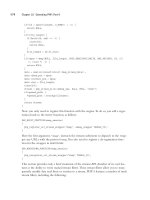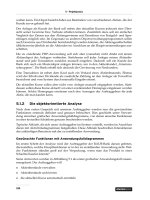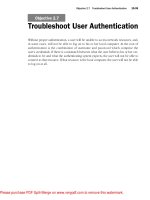PHP 5/MySQL Programming- P13 pdf
Bạn đang xem bản rút gọn của tài liệu. Xem và tải ngay bản đầy đủ của tài liệu tại đây (214.27 KB, 5 trang )
Run the page again. It works the same as before, but the URL of the resulting
page looks like this (presuming you said the user’s name is
Andy):
http://127.0.0.1/phab/ph02/hiUser.php?userName=Andy
The get method stashes all the form information into the URL using a special
code. If you go back to the
whatsName page and put in Andy Harris, you get a
slightly different result:
http://127.0.0.1/phab/ph02/hiUser.php?userName=Andy+Harris
The space between Andy and Harris was converted to a plus sign because space
characters cause a lot of confusion. When form data is transmitted, it often
undergoes a number of similar transformations. All the translation is automatic
in PHP programming, so you don’t have to worry about it.
Using a URL to Embed Form Data
If you understand how embedded data in a URL works, you can use a similar tech-
nique to harness any server-side program on the Internet (presuming it’s set up
to take
get method data). When I examined the URLs of Google searches, I could
see my search data in a field named
q (for query, I suppose). I took a gamble that
all the other fields would have default values, and wrote a hyperlink that incor-
porates a query. My link looked like this:
<li><a href = “ />Google search for “php”</a></li>
Whenever the user clicks this link, it sets up a get method query to Google’s
search program. The result is a nifty Google search. One fun thing you might
want to do is figure out how to set up canned versions of your most common
queries in various search engines, so you can get updated results with one click.
Figure 2.11 illustrates what happens when the user clicks the
Google search for
“php”
link in the linkDemo page.
Figure 2.12 shows the results of this slightly more complex search.
<li><a href =
“ for the absolute beginner”>
Google search for “programming absolute beginner”</a></li>
This approach has a down side. The program owner can change the program with-
out telling you, and your link will no longer work correctly. Most Web programmers
assume that their programs are called only by the forms they originally built.
TRAP
38
P
H
P
5
/M
y
S
Q
L
P
r
o
g
r
a
m
m
i
n
g
f
o
r
t
h
e
A
b
s
o
l
u
t
e
B
e
g
i
n
n
e
r
The other thing to consider is that people can do this with your programs. Just
because you intend for your program to be called only by a form, doesn’t mean
that’s how it always works. Such is the vibrant nature of the free-form Internet.
39
C
h
a
p
t
e
r 2 U
s
i
n
g
V
a
r
i
a
b
l
e
s
a
n
d
I
n
p
u
t
FIGURE 2.11
The link runs a
search on
www.google.com
for the term php.
FIGURE 2.12
The Google
search for
programming
absolute
beginner shows
some really
intriguing book
offerings!
40
P
H
P
5
/M
y
S
Q
L
P
r
o
g
r
a
m
m
i
n
g
f
o
r
t
h
e
A
b
s
o
l
u
t
e
B
e
g
i
n
n
e
r
Working with Multiple Field Queries
As one more practical example, the code for the National Weather Service link
looks like this:
<li><a href =
“ />Noblesville”>
National Weather Service Forecast</a>
for Noblesville, Indiana.
While this link looks a little more complex, it doesn’t require any special knowl-
edge. I simply searched the National Weather Service Web site until I found the
automatically generated page for my hometown. When I looked at the URL that
resulted, I was pleased (but not surprised) to see that the page was generated by
a PHP script. (Note the
.php extension in the URL.) I copied the link from my
browser and incorporated it into
linkDemo.html. The weather page is automati-
cally created by a PHP program based on two inputs (the county and city names).
Any time I want to see the local weather, I can recall the same query even though
the request doesn’t come directly from the National Weather Service. This is a
really easy way to customize your Web page.
I’ve never actually seen the program, but I know the PHP program requires two
fields because I looked carefully at the URL. The part that says
warncounty=INCO57
indicates the state and county (at least that’s a reasonable guess), and the
city=Noblesville indicates the city within the county. When a form has two or
more input elements, the ampersand (
&) attaches them, as you can see in the
National Weather Service example.
Reading Input from
Other Form Elements
A PHP program can read the input from any type of HTML form element. In all
cases, the
name attribute of the HTML form object becomes a variable name in
PHP. In general, the PHP variable value comes from the
value property of the
form object.
Introducing the borderMaker Program
To examine most of the various form elements, I built a simple page to demon-
strate various attributes of cascading style sheet (CSS) borders. The HTML program
is shown in Figure 2.13.
Building the borderMaker.html Page
The borderMaker.html page contains a very typical form with most of the major
input elements in it. The code for this form is as such:
<html>
<head>
<title>Font Choices</title>
</head>
<body>
<center>
<h1>Font Choices</h1>
<h3>Demonstrates how to read HTML form elements</h3>
<form method = “post”
action = “borderMaker.php”>
<h3>Text to modify</h3>
<textarea name = “basicText”
rows = “10”
cols = “40”>
Four score and seven years ago our fathers brought forth on this
41
C
h
a
p
t
e
r 2 U
s
i
n
g
V
a
r
i
a
b
l
e
s
a
n
d
I
n
p
u
t
FIGURE 2.13
The borderMaker
HTML page uses
a text area, two
list boxes, and
a select group.
continent a new nation, conceived in liberty and dedicated to the
proposition that all men are created equal. Now we are engaged in a
great civil war, testing whether that nation or any nation so
conceived and so dedicated can long endure.
</textarea>
<table border = 2>
<tr>
<td><h3>Border style</h3></td>
<td colspan = 2><h3>Border Size</h3></td>
</tr>
<tr>
<td>
<select name = borderStyle>
<option value = “ridge”>ridge</option>
<option value = “groove”>groove</option>
<option value = “double”>double</option>
<option value = “inset”>inset</option>
<option value = “outset”>outset</option>
</select>
</td>
<td>
<select size = 5
name = borderSize>
<option value = “1”>1</option>
<option value = “2”>2</option>
<option value = “3”>3</option>
<option value = “5”>5</option>
<option value = “10”>10</option>
</select>
</td>
<td>
<input type = “radio”
name = “sizeType”
value = “px”>pixels<br>
<input type = “radio”
name = “sizeType”
42
P
H
P
5
/M
y
S
Q
L
P
r
o
g
r
a
m
m
i
n
g
f
o
r
t
h
e
A
b
s
o
l
u
t
e
B
e
g
i
n
n
e
r









